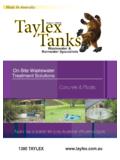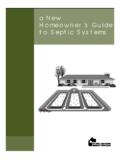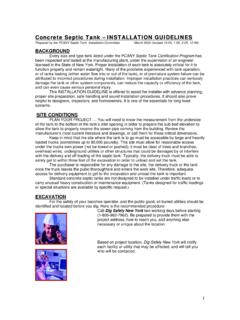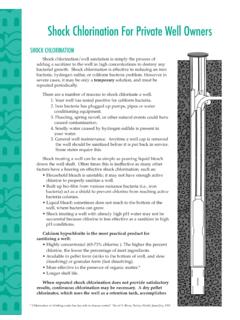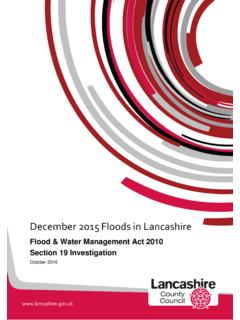Transcription of A Homeowner’s Guide - Taylex
1 SepticASystemstoGuideHomeowner sWhat s InsideYour septic system is your responsibilty.. 1 How does it work?.. 1 Why should I maintain my septic system ?.. 4 How do I maintain my septic system ?.. 5 What can make my system fail?.. 9 For more information.. 13A homeowner s Guide to septic Systems 1 Did you know that as a homeowner you re responsible for maintaining your septic system ? Did you know that maintaining your septic system protects your investment in your home? Did you know that you should periodically inspect your system and pump out your septic tank?
2 If properly designed, constructed and maintained, your septic system can provide long-term, effective treatment of household wastewater. If your septic system isn t maintained, you might need to replace it, costing you thousands of dol-lars. A malfunctioning system can contaminate groundwater that might be a source of drinking water. And if you sell your home, your septic system must be in good working Guide will help you care for your septic system . It will help you under-stand how your system works and what steps you can take as a homeowner to ensure your system will work properly.
3 To help you learn more, consult the resources listed at the back of this booklet. ComponentsA typical septic system has four main components: a pipe from the home, a septic tank, a drainfield, and the soil. Microbes in the soil digest or remove most contaminants from wastewater before it even-tually reaches groundwater. Your septic system is your responsibility!Howdoes it work?1. Regularly inspect your system and pump your tank as Use water Don t dispose of household hazardous wastes in sinks or Care for your Four Things You Can Do to Protect Your septic SystemTypical septic system2 A homeowner s Guide to septic SystemsA homeowner s Guide to septic Systems 3 Pipe from the homeAll of your household wastewater exits your home through a pipe to the septic tank.
4 septic tankThe septic tank is a buried, watertight container typically made of concrete, fiberglass, or polyethylene. It holds the wastewater long enough to allow solids to settle out (form-ing sludge) and oil and grease to float to the surface (as scum). It also allows partial decomposition of the solid materials. Compartments and a T-shaped outlet in the septic tank prevent the sludge and scum from leaving the tank and traveling into the drainfield area. Screens are also recommended to keep solids from entering the tanks generally have risers with lids at the ground surface to allow easy location, inspection, and pumping of the tank.
5 septic system aliases: On-lot system Onsite system Individual sewage disposal system Onsite sewage disposal system Onsite wastewater treatment systemTip To prevent buildup, sludge and floating scum need to be removed through periodic pumping of the septic tank. Regular inspections and pumping are the best and cheapest way to keep your septic system in good working order. Typical single-compartment septic tank with ground-level inspection risers and screen2 A homeowner s Guide to septic SystemsA homeowner s Guide to septic Systems 3 DrainfieldThe wastewater exits the septic tank and is discharged into the drainfield for further treatment by the soil.
6 The partially treated wastewater is pushed along into the drainfield for further treatment every time new wastewater enters the tank. If the drainfield is overloaded with too much liquid, it will flood, causing sewage to flow to the ground surface or create backups in plumbing fixtures and prevent treatment of all reserve drainfield, required by many states, is an area on your property suitable for a new drainfield system if your current drainfield fails. Treat this area with the same care as your septic system . SoilSeptic tank wastewater flows to the drainfield, where it percolates into the soil, which provides final treatment by removing harmful bacteria, viruses, and nutrients.
7 Suitable soil is necessary for successful wastewater treatment. Alternative systemsBecause many areas don t have soils suitable for typical septic systems, you might have or need an alternative system . You might also have or need an alternative system if there are too many typical septic systems in one area or the systems are too close to groundwater or surface waters. Alternative septic Finding Your SystemYour septic tank, drainfield, and reserve drainfield should be clearly designated on the as-built drawing for your home.
8 (An as-built drawing is a line drawing that accurately portrays the buildings on your property and is usually filed in your local land records.) You might also see lids or manhole covers for your septic tank. Older tanks are often hard to find because there are no visible parts. An inspector/pumper can help you locate your septic system if your septic tank has no risers. 4 A homeowner s Guide to septic SystemsA homeowner s Guide to septic Systems 5systems use new technology to improve treatment processes and might need special care and maintenance.
9 Some alternative systems use sand, peat, or plastic media instead of soil to promote wastewater treatment. Other systems might use wetlands, lagoons, aerators, or disinfection devices. Float switches, pumps, and other electrical or mechanical components are often used in alternative systems. Alternative systems should be inspected annually. Check with your local health department or installer for more information on operation and maintenance needs if you have or need an alternative septic systems are properly designed, constructed, and maintained, they effectively reduce or eliminate most human health or environmental threats posed by pollutants in household wastewater.
10 However, they require regular maintenance or they can fail. septic systems need to be monitored to ensure that they work properly throughout their service lives. Saving moneyA key reason to maintain your septic system is to save money! Failing septic systems are expensive to repair or replace, and poor maintenance is often the culprit. Having your septic system inspected regularly is a bargain when you consider the cost of replacing the entire system . Your system will need pumping depending on how many people live in the house and the size of the system .

